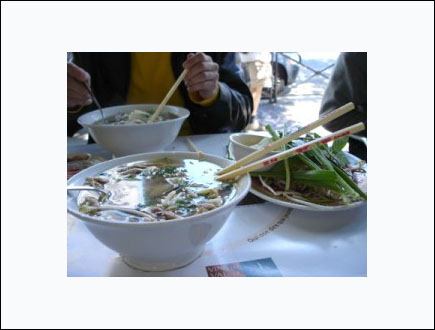
What happens when two restaurant and travel writers meet to test a restaurant together? Do they eye each other warily over tall menus? Do they try to outdo each other with the quality of their inquiry to the waiter? Do they make hyper-critical commentary about sauces and textures out of fear of enjoying themselves too much in public? Do they speak of their travels as though through the pages of a glossy magazine, punctuating descriptions with “Oh you haven’t been? You really should go. It may have already peaked.”
Others might. Heather Stimmler-Hall and I went for pho, the Vietnamese kitchen-sink soup that is very much at home in Paris’s main Asian quarters.
Heather has a long list of guidebook and article credits to her name and publishes a spunky newsletter, which could make us jealous competitors were it not for the fact that we are earnest members of each other’s fan club. She lives just beyond the reaches of Paris’s Chinatown in the 13th arrondissement, and I lived in the same area in the 1990s, so a bowl of pho seemed a natural place to get culinarily acquainted.
Heather chose the setting for this our first joint restaurant test, Pho Banh-Cuon 14, a non-descript little restaurant that’s a five-minute walk from Place d’Italie (metro stop of the same name) along avenue de Choisy, at the entrance to Paris’s main Chinatown in the 13th arrondissement. But most any restaurant in the area with Pho in it’s name would have done.
By most accounts pho developed in northern Vietnam and was enriched in the south by northern Vietnamese who had fled the Communists. Many conveniently speculate that pho (pronounced fuh) is in fact the Vietnamization of the French feu (fire), as in pot-au-feu.
France’s steamy pot-on-the-fire stew of broth, beef flank, root and leaf vegetables (carrots, turnips, parsnips, leeks, celery) is indeed much like pho. Both are hearty and generous. Pho, however, pho is basically table-side fast food, though unlike most other Asian fast-food in Paris pho is generally fresh. Service is necessarily of the no-frills kind: you choose, you’re served, you throw some leaves and sauce in your soup, you eat, you ask for the check, you pay.
Actually, you don’t so much choose as renounce, which is why foreign eating can be such a religious experience. You will indeed find several choices of phos and Tonkin soups on the menu at Pho Banh-Cuon 14, as you will at other pho joints, but ask the waiter the difference between them and he may well answer, as he did to us, “C’est pareil,” which, for those who do not speak Parisian Server, means, “Just pick one, I’ve got tables waiting.”
The only true option then is between grand and petit, though the 1€ difference between the mama-size bowl and the papa-size bowl makes even that decision irrelevant. In short, when a restaurant has Pho in its name you order pho, and if you mistakenly point on the menu to the soup with tripes in it instead of meatballs, or meatballs instead of beef flank, or if those meatball prove to be a bit too tough, well, just fish out the unwanted protein and enjoy the rest. That rest is sure to please the easy-going traveler, particularly when your neighborhood explorations lead you near one of Paris’s Asian-leaning quarters around lunchtime. (In addition to the high-rise Chinatown in the 13th arrondissement, a second swath of Asian influence gathers around metro Belleville, at the juncture of the 12th, 11th, 19th, and 20th arrondissements.
One fundamental difference between pot-au-feu and pho is that when you order the former in France the waiter will likely tell you how to eat it whereas when you order the latter you’re on your own. The steamy pho broth contains flat rice noodles and the aforementioned protein and is served with a side pile of bean sprouts, cilantro, scallions, and basil, a slice of lemon or lime, chopped red or green chili peppers, a side dollop of hosin or “plum” sauce, and a bottle of fish sauce. It’s up to you to figure out how it all goes together. To taste, of course, but for those without much of a sense of pho taste I can only advise that you start throwing and stirring things into the bowl… and enjoy a warm and tasty lunch with chopsticks and spoon.
A bit of splattering may occur in the process, but as the saying goes: keep your friends close and your phos closer.
…
– Pho Banh-Cuon 14, 129 avenue de Choisy, 13th arrondissement. Metro Place d’Italie. Tel. 01 45 83 61 15.
© 2006, Gary Lee Kraut

